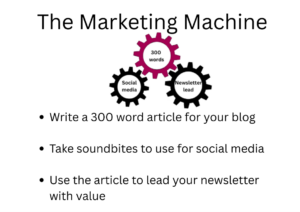
If you’re making a presentation to get an idea, a concept across or to persuade your audience to take action on something, sometimes words are not enough.
As the saying goes ‘a picture says a thousand words’, some things are just easier to explain with the aid of an image. Diagrams, charts, product images are all great aids to your presentation.
A good slide deck is worth its weight in gold, but there are some vital things to remember.
The slide deck is a visual aid – not a verbal aid
It should not be your notes on screen. Firstly, because you should not be reading the screen as you lose contact with your audience. Secondly, because text-heavy slides divert attention from you to the slides. Some of your audience will read and re-read your slides, instead of listening to you.
Keep it simple
Images need to be simple and easy to understand. If it takes you ten minutes to explain your diagram, it’s not a good visual aid. Bar charts and pie charts that show clear differentials are great, but don’t get too complicated. A month-by-month growth chart, with nice fat bars, is much easier for your audience to process than a day-by-day version, with dozens of tiny lines.
Don’t go to the other extreme and put images on the screen with no explanation. If you’re putting a graph up, add the title and the designation of your vertical and horizontal values – at least.
This also means NOT using fancy fonts. A simple sans-serif font is the easiest on the audience’s eyes. Ensure text is big enough to be read from a distance, don’t make your audience work too hard to decipher your message.
Quality over quantity
Every slide must work for its place. 80 slides for a 10 minute presentation is far too many! (And yes, I’ve seen this. The presenter, could almost not have been present, he just clicked from slide to slide and everything was on the screen.) Pare your slides down to the essentials.
Words have a place
There’s nothing wrong with the (very) occasional quotation, as long as it has value in your presentation.
Sometimes, if you have a step-by-step process, including the steps will help the audience to get that process accurately. My own rule of thumb is no more than three one-line bullet points on a single slide.
e.g.
- Write a 300 word article for your blog
- Take soundbites to use for social media
- Use the article to lead your newsletter with value
I would use a graphic to demonstrate, so the slide would look like this:
Stay in control
When you’re not talking about a slide turn it off! When there is information on a screen people tend to re-read, re-examine and are not concentrating on the speaker. If you hit B on your keyboard, the screen will go black – and do it again and you’re back on your slides. (W makes the screen go white, but that often means you end up as a backlit silhouette!). Some clickers have an option for a blank screen too.
A well-designed slide deck will help to keep your audience engaged and underline your key points professionally. Most slide builders will offer help with structure and design – or use an AI aid like Gamma.
Keep in mind that you are the presenter, not your slide-deck, so ensure that the focus is on you.
